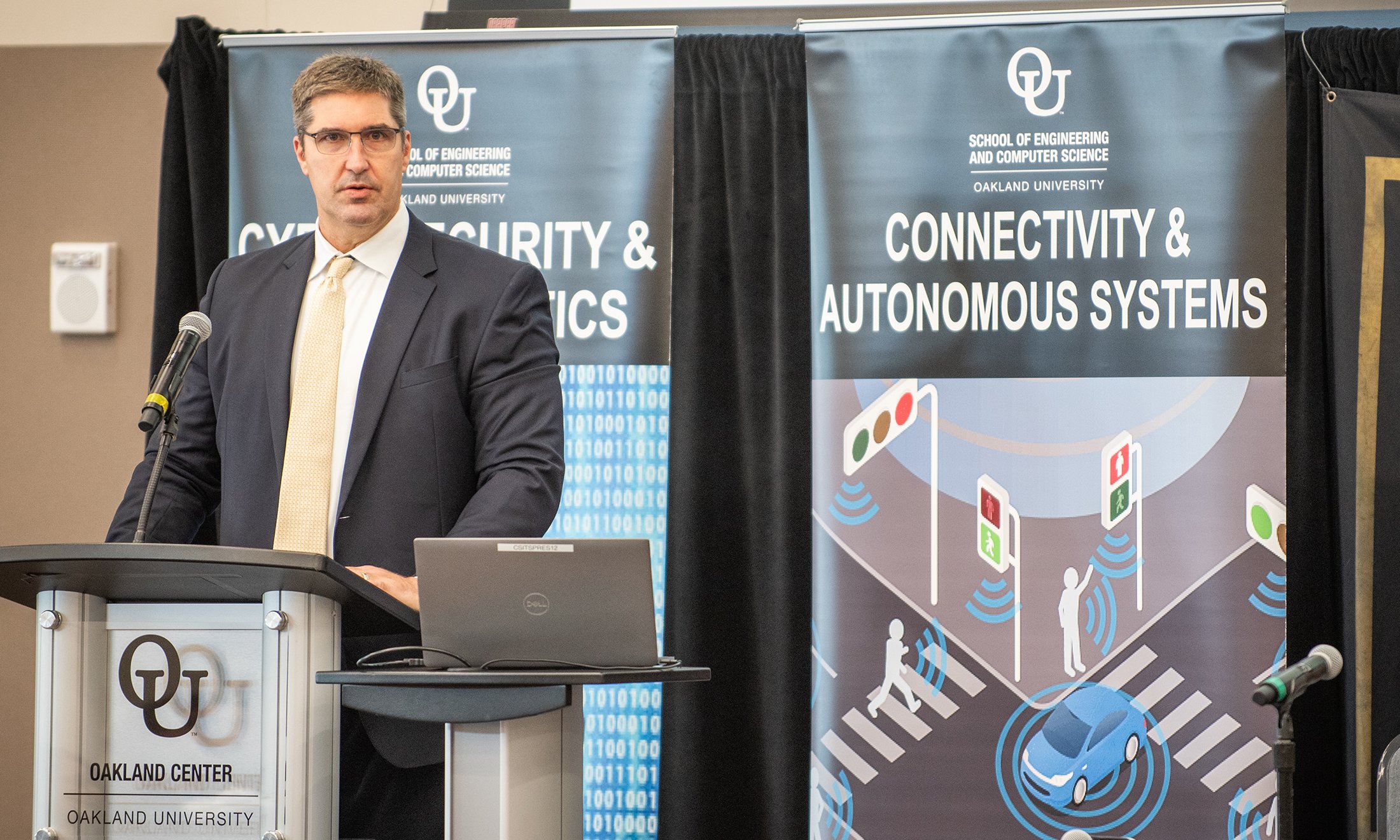On the Receiving End
With $3 million in grant funding from the National Institute for Standards and Technology, School of Engineering and Computer Science will acquire an indoor Automotive Antenna Measurement System capable of performing both on-vehicle full-scale three-dimensional antenna pattern measurements and over-the-air testing of wireless communication systems.
With 3 million dollars in grant funding from the National Institute for Standards and Technology for the proposal entitled “Oakland University Vehicular Wireless Communications System Testing and Standards Facility,” Oakland University’s School of Engineering and Computer Science will acquire an indoor Automotive Antenna Measurement System (AAMS) capable of performing both on-vehicle full-scale three-dimensional antenna pattern measurements (APM) and over-the-air testing (OTA) of wireless communication systems.
Daniel Aloi, Ph.D., professor of electrical and computer engineering, SECS Director of Research, and the principal investigator for this award, believes that this funding will make a significant regional and national impact. As the only independent, multi-user, shared-use unit with this capability in the United States, AAMS will support research, development, training, and the certification of automotive wireless communication systems.
To increase safety, convenience and entertainment of vehicle occupants, the automotive industry is aggressively pursuing wireless technologies. This, in turn, creates a critical need for educating the next generation of automotive antenna/wireless communications engineers. Additionally, vehicle-level antenna testing and wireless system testing, required for the development and adoption of safety-critical wireless technologies, is a complex and expensive process. Thus, a center for automotive electromagnetics research, incorporating an independent antenna/wireless communications test capability for both research and industry, becomes of an upmost importance.
“The acquisition of the AAMS is intended to replace the existing OU antenna testing instrument that has been housed in the Applied EMAG and Wireless Laboratory and successfully operated and maintained for over 15 years. During this time, we have developed a community of users, including OU research faculty, faculty from other universities, and industry, as well as trained students, supported a variety of outreach and workforce development programs, and helped recruit new students. Due to new technology emerging in wireless communications, the current instrument can no longer support these activities,” shares Dr. Aloi, who will function as a principal investigator and the Director for the AAMS, with support of Amanpreet Kaur, Ph.D., assistant professor of electrical and computer engineering.
The AAMS is expected to enable research in antenna design for Global Navigation Satellite Systems (GNSS), Vehicle-to-Everything (V2X), and Cellular 5G communications. The antenna solutions for these areas are challenging because they cover wide frequency ranges, are co-located under the same radome and have strict size limitation requirements. Furthermore, the next generation of antenna solutions will come in the form of smart arrays. These arrays need to be conformed and miniaturized, while still providing the necessary pattern coverage and resistance to interference and cyber-security risks.
“As the number and complexity of wireless systems are integrated into the automobile, the need for a process to certify AAMSs for the measurement of on-vehicle antenna performance is imperative. The new equipment will be utilized to investigate both measurement error uncertainty bounds and measurement system certification procedures that will serve as the foundation for much needed automotive standards for accurate vehicle-level APMs across AAMSs. This will optimize the performance of cellular, GNSS and V2X wireless technologies leading to increased automotive safety on the roadways. We will also utilize this equipment for antenna measurement research to introduce new algorithms, establish measurement accuracy bounds, and work with standards committees for range certification standards,” says Dr. Aloi.
The AAMS will be located in the School of Engineering and Computer Science’s Research and Innovation Center - off-campus facility is located two miles from the main campus.
"As an indoor anechoic chamber, it will not experience weather-related down time, providing better learning opportunities for our students. We expect that the research results generated as a result of the new AAMS will allow our students grow as researchers and share their fundings with industry and scientific community through publications, presentations, theses, and dissertations,” says Louay M. Chamra, dean of the School of Engineering and Computer Science.
One of the first research efforts intended for AAMS are to take advantage of the current outdoor spherical near-field range with conductive ground and the new indoor spherical near-field system in a free space environment to do an extensive accuracy analysis between these different facilities between 600 MHz to 6,000 MHz. The aim of this research is to understand the accuracy limitations that come with vehicle-level hemispherical near-field antenna measurements in terms of accuracy and to roll those into range certification procedure recommendations for the automotive community.
For more information, please contact Dr. Aloi at [email protected].

 December 20, 2023
December 20, 2023
 By Arina Bokas
By Arina Bokas









